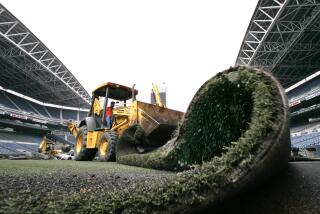A Shift From Concrete to Common Sense
- Share via
Next season, the proprietors of Giants Stadium will remove the artificial surface and replace it permanently with grass.
In Cincinnati, the Bengals will move from the painted green of Cinergy Field to the real green in new Paul Brown Stadium. The same thing will happen when the Pittsburgh Steelers move into their new stadium in 2001.
Call this trend a switch from concrete to common sense.
Right now, 17 NFL teams are playing on grass and 14 on artificial surfaces. Next year, the numbers will be 20-11 in favor of grass.
In a survey conducted by the NFL Players Association last season, 86.6 percent of the 957 respondents said they preferred to play on natural grass and 94.2 percent said artificial turf is more likely to contribute to injuries. Four of the five fields at the bottom of the players’ list had artificial surfaces.
The results were hardly a surprise.
Previous surveys conducted in 1994 and 1996 produced similar results. The most recent survey also reported that just 4.9 percent of the players preferred artificial turf.
The ones who liked the stuff were probably kickers. Those guys don’t get bounced around and banged up as frequently as other players.
The hallmark of this NFL season is the injured reserve list that has claimed a fistful of high-profile names like Vinny Testaverde, Jamal Anderson, Michael Irvin, Terrell Davis, Dan Marino and Steve Young, most of them out for the season.
It would be presumptuous to blame all the injuries on artificial turf. It would be foolish to ignore the fake stuff’s involvement.
More than three decades worth of turf has created a long casualty list and made fans experts on medical terminology like concussions, clavicles, and perhaps the No. 1 target of fake turf, anterior cruciate ligaments.
The irony of all this is that when the manufacturers first brought out the artificial carpet, they promoted it as a safe alternative to grass, a surface that would cut down injuries. Allie Sherman was coaching the New York Giants in those days.
“At the time, there had been a higher degree of injuries,” Sherman said last week at The Boys Club of New York’s Hall of Fame dinner. “They came in with three swatches of turf and said this stuff would minimize injuries. I thought that would be great. I told them to go for it.”
What the turf does is create greater leverage and traction. That’s terrific for a kicker, but not so great for a runner or quarterback, who absorbs a hit when his leg is planted, gripping the ground.
Sherman tapped his foot on a carpeted floor.
“There’s some padding under there, but it’s hard under that,” he said. “That’s how it is on an artificial surface. Today’s defenders are tougher and smarter. They’re bigger and quicker. They’re more mobile. They have a greater ability to generate power.
“That turf doesn’t have much under it and the delivery of the blow, when that’s absorbed, that can be tough. It’s like playing on a frozen field. When I coached, I told my players, ‘You deliver the block, don’t catch it.”’
This would seem to be good advice in all situations, particularly on artificial turf.
“With artificial turf, there’s better traction and better ability to generate power and deliver a stronger blow,” Sherman said. “The league is in a tough position. A lot of teams are going back to grass. I’m sure the players are glad.”
The switch from rugs to grass means another significant change.
Groundskeepers can put away the vacuums and get out the hoses.
More to Read
Go beyond the scoreboard
Get the latest on L.A.'s teams in the daily Sports Report newsletter.
You may occasionally receive promotional content from the Los Angeles Times.










